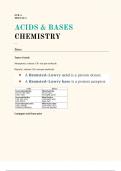Titration acids and bases - Study guides, Class notes & Summaries
Looking for the best study guides, study notes and summaries about Titration acids and bases? On this page you'll find 147 study documents about Titration acids and bases.
Page 4 out of 147 results
Sort by
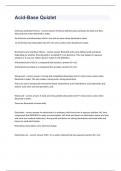
-
Acid-Base Quizlet questions with 100% correct answers rated A+ 2023/2024
- Exam (elaborations) • 3 pages • 2023
-
Available in package deal
-
- $9.99
- + learn more
Acid-Base QuizletArrhenius Acid-Base Theory - correct answer Arrhenius defined acids and bases by what ions they dissociate into when dissolved in water. An Arrhenius acid dissociates into H+ ions and an anion when dissolved in water. An Arrhenius base dissociates into OH- ions and a cation when dissolved in water. Bronsted-Lowry Acid-Base Theory - correct answer Bronsted and Lowry defined acids and bases depending on whether they donated or accepted H+ ions (protons). This may happen in a...
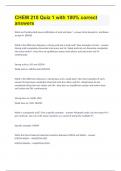
-
CHEM 210 Quiz 1 with 100% correct answers
- Exam (elaborations) • 2 pages • 2023
-
Available in package deal
-
- $14.49
- + learn more
What are the Bronsted-Lowry definitions of acid and base? Acids donate H+ and Bases accept H+ (BAAD) What is the difference between a strong acid and a weak acid? Give examples of each. Strong acids completely dissociate into anion and H+. Weak acids do not dissociate completely into anion and H+, they form an equilibrium system and reform acid and anion and H+ continuously. Strong acid ex. HCl and H2SO4 Weak acid ex. H3PO4 and HC2H3O2 What is the difference between a strong ...
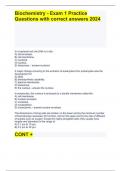
-
Biochemistry - Exam 1 Practice Questions with correct answers 2024
- Exam (elaborations) • 16 pages • 2024
-
Available in package deal
-
- $7.99
- + learn more
In a bacterial cell, the DNA is in the: A) cell envelope. B) cell membrane. C) nucleoid. D) nucleus. E) ribosomes. - answer-nucleoid A major change occurring in the evolution of eukaryotes from prokaryotes was the development of: A) DNA. B) photosynthetic capability. C) plasma membranes. D) ribosomes. E) the nucleus - answer-the nucleus In eukaryotes, the nucleus is enclosed by a double membrane called the: A) cell membrane. B) nuclear envelope. C) nucleolus. D) n...
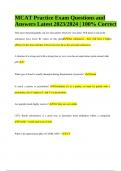
-
MCAT Exam Practice Questions With Answers Latest Updated 2024 (100% Verified)
- Exam (elaborations) • 19 pages • 2024
-
- $15.49
- + learn more
MCAT Exam Practice Questions With Answers Latest Updated 2024 (100% Verified) Thin layer chromatography can use silica plates which are very polar. Will polar or non polar substances have lower Rf values on this plate? Polar substances - they will have a higher affinity for the silica and thus will not travel as far as the non polar substances A titration of a strong acid with a strong base or vice versa has an equivalence point around what pH? 7 What type of bond is usually disrupted duri...
summary notes on acids, bases, pH, buffers and titration curves (chapters 20-21 on the kerboodle textbook) for module 5 revision. diagrams and example calculations included
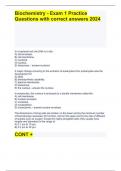
-
Biochemistry - Exam 1 Practice Questions with correct answers 2024
- Exam (elaborations) • 16 pages • 2024
-
Available in package deal
-
- $7.99
- + learn more
In a bacterial cell, the DNA is in the: A) cell envelope. B) cell membrane. C) nucleoid. D) nucleus. E) ribosomes. - answer-nucleoid A major change occurring in the evolution of eukaryotes from prokaryotes was the development of: A) DNA. B) photosynthetic capability. C) plasma membranes. D) ribosomes. E) the nucleus - answer-the nucleus In eukaryotes, the nucleus is enclosed by a double membrane called the: A) cell membrane. B) nuclear envelope. C) nucleolus. D) n...
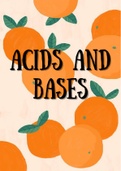
-
Grade 12 Acids and Bases
- Summary • 9 pages • 2022
-
- $3.38
- 2x sold
- + learn more
This is a summary of the important aspects of Acids and Bases in the Grade 12 syllabus: - Cover page - Acids - Bases - Concentrated vs Dilute - Conjugate acid-base pairs - Amphoteric Substances - The pH scale - Acid Reactions - Kw, Ka and Kb - Hydrolysis - Titration/Neutralisation - Conductivity of acids and bases
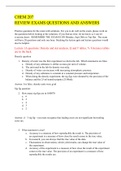
-
CHEM 207 REVIEW EXAMS QUESTIONS AND ANSWERS
- Exam (elaborations) • 12 pages • 2022
-
- $9.49
- 1x sold
- + learn more
CHEM 207 REVIEW EXAMS QUESTIONS AND ANSWERS Practice questions for the exam with solutions. For you to do well on the exam, please work on the questions before looking at the solutions. If you find an error, let me know so I can let everyone know. REMEMBER THE EXAM IS ON Monday, Sept 28th on Top Hat. The exam will have 20 questions and only one hour. Studying the lecture ppts and lecture questions would also be helpful. Lecture 1A questions: Density and stat analysis, Q and T tables, % Tole...

-
ACS Chemistry Final Exam 182 Questions with Verified Answers,100% CORRECT
- Exam (elaborations) • 18 pages • 2024
-
- $12.99
- + learn more
ACS Chemistry Final Exam 182 Questions with Verified Answers Layout of an element (mass # & atomic #) - CORRECT ANSWER atomic number = - CORRECT ANSWER # of protons mass number = - CORRECT ANSWER # of protons + neutrons the number of protons in a neutral atom will equal the - CORRECT ANSWER # of electrons how to find the correct number of neutrons - CORRECT ANSWER mass number - atomic number Forms of the same elements that differ in amount of neutrons - CORRECT ANSWER isotopes...
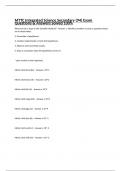
-
MTTC Integrated Science Secondary (94) Exam Questions & Answers Solved 100%
- Exam (elaborations) • 56 pages • 2024
- Available in package deal
-
- $14.99
- + learn more
What are the 5 steps in the Scientific Method? - Answer 1. Identify a problem or pose a question based on an observation. 2. Formulate a hypotheses. 3. Conduct experiments or tests the hypotheses. 4. Observe and record the results. 5. Draw a conclusion (was the hypothesis correct?). * peer review is also important. Metric Unit deca (da): - Answer x 10^1 Metric Unit hecto (h): - Answer x 10^2 Metric Unit kilo (k): - Answer x 10^3 Metric Unit mega (M): - Answer x 10^6 Metric ...

$6.50 for your textbook summary multiplied by 100 fellow students... Do the math: that's a lot of money! Don't be a thief of your own wallet and start uploading yours now. Discover all about earning on Stuvia

